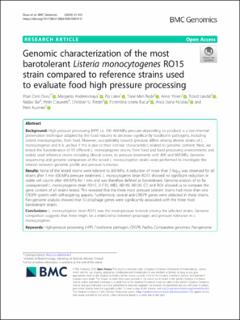| dc.description.abstract | Background: High pressure processing (HPP; i.e. 100–600 MPa pressure depending on product) is a non-thermal preservation technique adopted by the food industry to decrease significantly foodborne pathogens, including Listeria monocytogenes, from food. However, susceptibility towards pressure differs among diverse strains of L. monocytogenes and it is unclear if this is due to their intrinsic characteristics related to genomic content. Here, we tested the barotolerance of 10 different L. monocytogenes strains, from food and food processing environments and widely used reference strains including clinical isolate, to pressure treatments with 400 and 600 MPa. Genome sequencing and genome comparison of the tested L. monocytogenes strains were performed to investigate the relation between genomic profile and pressure tolerance. Results: None of the tested strains were tolerant to 600 MPa. A reduction of more than 5 log10 was observed for all strains after 1 min 600 MPa pressure treatment. L. monocytogenes strain RO15 showed no significant reduction in viable cell counts after 400 MPa for 1 min and was therefore defined as barotolerant. Genome analysis of so far unsequenced L. monocytogenes strain RO15, 2HF33, MB5, AB199, AB120, C7, and RO4 allowed us to compare the gene content of all strains tested. This revealed that the three most pressure tolerant strains had more than one CRISPR system with self-targeting spacers. Furthermore, several anti-CRISPR genes were detected in these strains. Pan-genome analysis showed that 10 prophage genes were significantly associated with the three most barotolerant strains. Conclusions: L. monocytogenes strain RO15 was the most pressure tolerant among the selected strains. Genome comparison suggests that there might be a relationship between prophages and pressure tolerance in L. monocytogenes. | |
